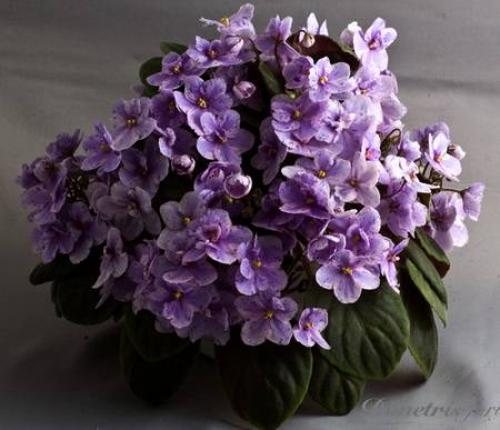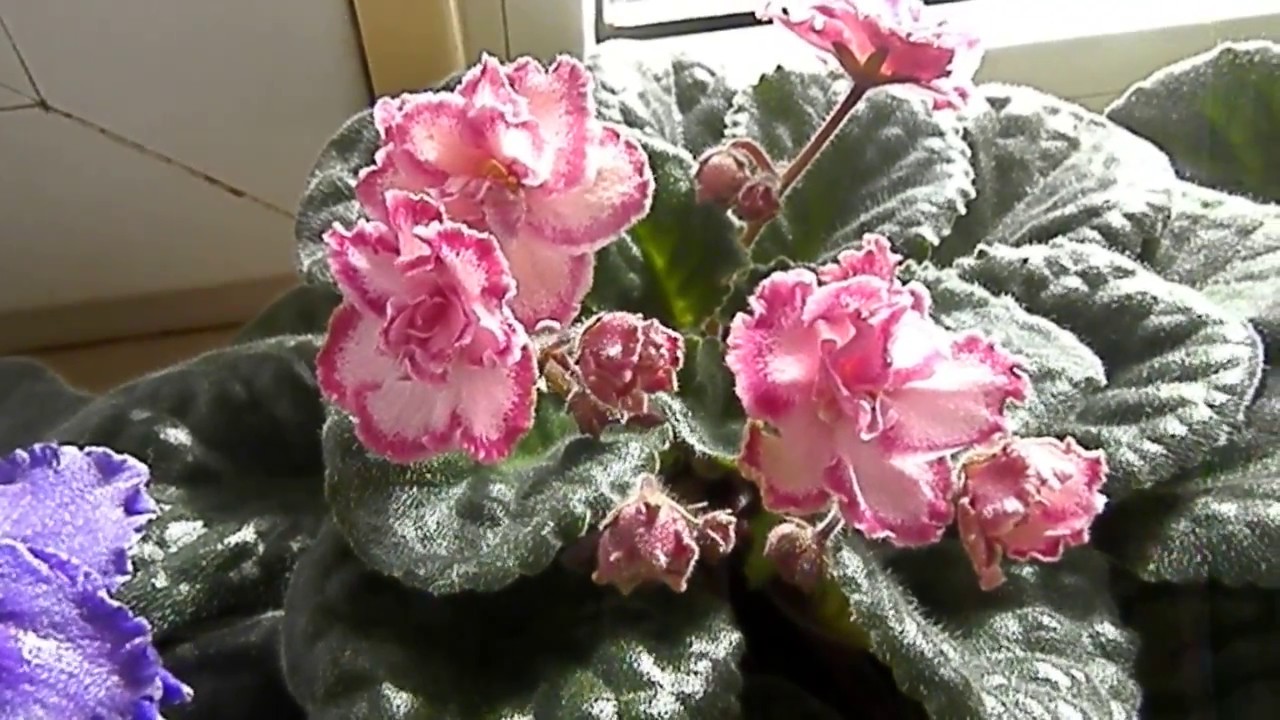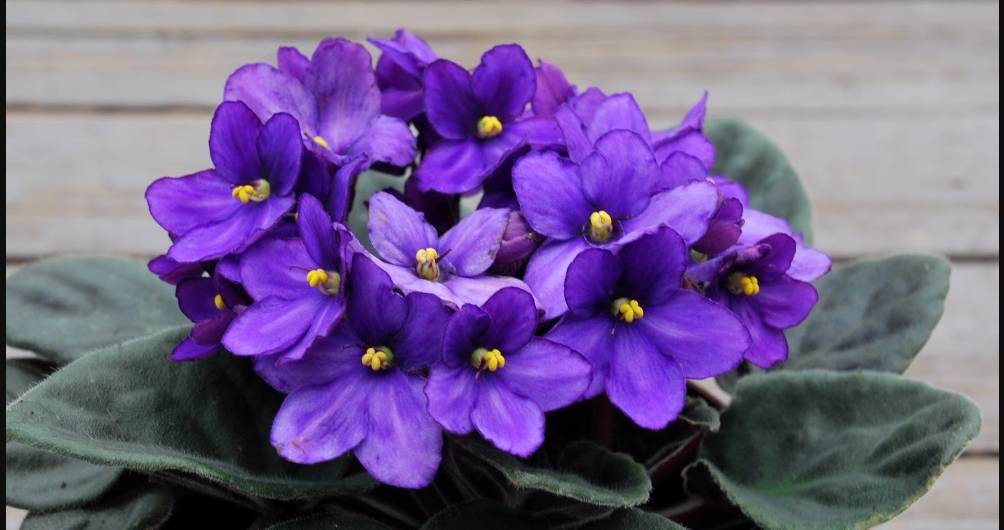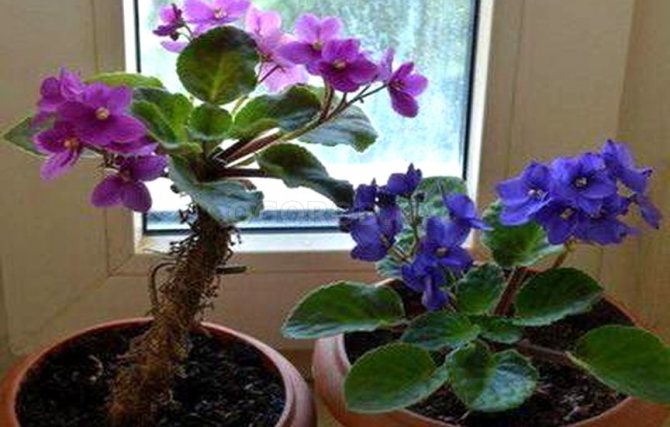Why do violets have flowers under the leaves.

Usambara violet.
Family Gesneriaceae - Gesneriaceae.
Genus Saintpaulia hybrida - Hybrid Saintpaulia.
African violet saintpaulia hybrid.
Blooming violets
Flowers are formed like a violet.

A variety that produces a large number of flowers at the same time is called profusely. What area do the flowers occupy? A plant that has ten very large flowers can be more spectacular than a plant that has twice as many tiny ones. The size of flowers directly depends on their shape. It is much easier to realize large, star-shaped flowers with evenly spaced petals of the same size.
Duration, duration of flowering. It is clear that the number of flowers in a certain period of time will be large if each corolla remains fresh for as long as possible. Thicker and juicier flowers retain their freshness and color longer than thin, paper-like flowers. Flowers with green petal edges, fringes or backs always live longer.
The more green the violet flowers have, the longer the flowers will be fresh and vigorous. If the variety has long flower stalks and a wreath, then they can bloom for a very long time. Light enters the center of the outlet, new normal leaves grow and new buds are formed all the time.
The regularity of flowering. Another choice that a collector must make is an intermittent or permanent blooming variety. Ideally, they don't stand without flowers at all. An additional benefit is that plants that regularly produce buds have fewer stepsons. The violet usually blooms within 2 months. Then there is a break for about 2-3 months: at this time, the plant grows young leaves, in the axils of which new peduncles will appear.

Bloom type. There are two main paths - "bouquet" or "corolla, halo". A bouquet of flowers appears in a bunch, held on strong, vertical peduncles above the center of the rosette. In the case of flowering with a crown, the center of the plant remains visible, the peduncles are located at an angle, the flowers look like a ring above the foliage.
Peduncles appear in the leaf axil above the base of the petiole. Consequently, healthy leaves will produce strong flower stalks. Thus, the plant should come up to the moment of setting flower stalks with strong, normally developed leaves. One peduncle grows from each leaf. Peduncles are usually laid not one at a time, but three, because the violet generally grows so that three leaves grow from one point at the same time. Then the next, three more. Sometimes these leaves are confused with the concept of a tier, but a tier is different. At this time, the violet can be fed with phosphorus-potassium fertilizer Water regularly and see how quickly the peduncles grow. Simultaneously with the laying of the peduncles, new, young roots are formed.
A tier is a dozen leaves with the same petiole length, forming a full skirt around the circumference of the rosette. The outer tier is most often 12-15 leaves, it is partially overlapped by the second, in which the number of leaves is smaller, then on top, perhaps the third, in which there are already only six pieces, and then the flowering top. Let me remind you that we are talking about prize exhibition standards, fully leafy, growing in a nine-pot.
Peduncles growing from this triplet of leaves do not develop completely simultaneously, but in turn. There is always a more developed senior, there is an average, and a slightly later junior. Under favorable light conditions, after a certain development of these three, the following three appear. And so on. Those. under natural conditions, the violet, as the leaves grow, lays little flower stalks and little by little continues to grow the next leaves.

This is a gradual process, therefore, until the third three grows, the first peduncles will have time to grow well and develop buds, the difference between them will be very large. The following young leaves growing from above also develop leaf plates, coarse. The peduncles can no longer raise them, they are forced to grow under the leaf forward in order to come out into the white light. Over time, the peduncles cease to be soft and plastic, they become tough. Attempts to pick them up, pull them out or redirect them end up in offensive breaking off.

Why violets do not bloom and what to do if the leaves:
 Often, inexperienced growers cannot get the full bloom of violets, which means that there are certain violations in the care and the plant lacks some elements.
Often, inexperienced growers cannot get the full bloom of violets, which means that there are certain violations in the care and the plant lacks some elements.
It is necessary to revise everything that has been done to care for the non-flowering Saintpaulia and correct the mistake in the care. This will help the plant to bloom.
Grow well
If the violet does not bloom, but only leaves of large sizes and in large quantities grow, this means that the flower has been overfed with fertilizer, where the nitrogen part is a large proportion of the top dressing. Such foliage:
- large;
- shiny;
- plump;
- perfect shape.
A lot of leaves is not always good, because with this beauty, an adult violet fattens and does not bloom, and a florist cannot wait for at least one flower.

It looks like a fatty violet bush.
The first thing to do if the violet gives only foliage is to stop any feeding for a month or more, and then start feeding only with the fertilizer that is intended for flowering plants. In them, a large proportion belongs to phosphorus and potassium, and only then to nitrogen. The first 2 components contribute to the setting of buds and further abundant flowering. If there is not enough potassium, the plant will be completely deprived of flowering.
IMPORTANT! Fertilizers are applied only after watering to protect the root system from burns.
Stopped growing
 Usually, in winter or summer, in the heat, the leaf plates become lifeless, and the plant does not seem to die, but does not have any growth that can be noticed. In addition, flowering is completely absent.
Usually, in winter or summer, in the heat, the leaf plates become lifeless, and the plant does not seem to die, but does not have any growth that can be noticed. In addition, flowering is completely absent.
If violets do not grow or bloom, then the reason is low air humidity. Therefore, to increase the humidity, you can place small jars of water around the plants and monitor the water level in them.
Or in winter, you can put a wet towel on a hot radiator, and the moisture evaporates and saturates the air in the room. Also, some growers purchase an air humidifier that humidifies all the air in the apartment.
It is not recommended to spray violets with water, as you can completely ruin the rosette of leaves.
Crushed
If the violet grows only small leaves and does not bloom, then the reason for this phenomenon can be sought in the absence of fertilizing at all. In order for the plant to develop well, the violet must be transplanted annually into new soil and do not forget to feed it according to the instructions.
It must be remembered that the violet is a rather "gluttonous" plant.

The growth of small leaves indicates a lack of nutrition.
Grow up
If the leaf plates of the violet are raised up and this is not due to its variety, then most likely the Saintpaulia does not have enough illumination in the place where it stands at home - this reason is easily eliminated.
If this happened in the winter, then you need to get special lamps to illuminate the plants on cloudy winter days. Since for full development and flowering, it needs 12-hour daylight hours.
If in winter the flowers stand on the southern windowsill in direct sunlight in the southern regions of Russia, then this can cause burns to individual leaves. So the placement of flowers also depends on the region of residence of the grower.
Turn yellow
 Most likely, the violet rosette has not been transplanted for a long time, or the earth is of poor quality and lacks trace elements.
Most likely, the violet rosette has not been transplanted for a long time, or the earth is of poor quality and lacks trace elements.
Because the plant spends a lot of energy on flowering, but it cannot nourish the strength, since the soil is initially spoiled and it has to take nutrients from the leaves.
Therefore, you can feed the plant and, if this does not help, then transplant the bush with a complete replacement of the soil.
Watering violets
Any varieties of violets require moderate watering with settled water at room temperature or slightly warmed up. Water the plant 1-2 times a week. Watering frequency depends on the season, soil quality and room temperature.
In summer, spraying is useful for violets from time to time, but the sun's rays should not fall on wet leaves, otherwise a burn cannot be avoided.
With proper watering, the soil is moist, but not wet; in the dampness, the rosette and roots rot.
There are 4 ways of watering violets:
Watering in a tray under the pot
After the plant has absorbed the required amount of liquid, its excess is poured out.
You can put the flowerpot in a wide basin of water, and after half an hour, return it to its original place.
Top watering - in this case, it is important that water does not get on the flower rosette and leaves.
itchy. It is used by collectors with a large number of flowers
A thin cord is laid out between the drainage and earthen layers, one end of which comes out through the drainage holes in the bottom of the flowerpot. The pot is placed on a container of water, covered with a lid, dipping only a wick into it. In this case, you need to periodically add water to the lower container.

Home remedies
In addition to ready-made fertilizers, there are home remedies:
- Used tea leaves have a positive effect on the soil - they nourish it and make it friable. But this is also a favorable breeding ground for midges, so this fertilizer must be constantly updated.
- Coffee grounds are used for plants that prefer acidic soils. For violets, they need to be applied in small quantities - no more than 2 spoons per pot.
- The citrus peel is dried and then placed in a three-liter jar, half full. Then boiling water is poured so that the whole zest is in the water. Infusion lasts 2 days. Then you need to remove the crusts and add boiled water. Once a month, root or foliar feeding of the plant is carried out with a ready-made infusion. In the same way, a banana peel-based infusion is prepared. It must be dried, crushed and added to the earthen mixture during transplanting.
- Glucose. The tablet is dissolved in warm water (1 liter). It is used once a month for foliar feeding.
- Sugar. It will take 1 tsp. product for 1 plant once a week. They need to sprinkle the ground before watering. Watering with sugar syrup is allowed - 2 tsp. for 1 glass of water.
- Onion peel. The husk (100 g) must be poured with boiling water and brought to a boil. Then infusion is performed for 2 hours and straining. The plant must be sprayed with a spray bottle using infusion.
- Yeast. The product accelerates the growth of violets. In terms of nutritional value, yeast is similar to complex mineral fertilizers. The product is prepared as follows: 1 g of dry substrate and a pinch of sugar are added to 1 liter of warm water. After two hours of infusion, dilute the mixture with a fivefold amount of warm water, then you can water the flowers with it.
Home remedies work just as well as store-bought ones. If you cook and use them correctly, after a while the violet can bloom beautifully.
Improper plant care
The main reasons why this type of indoor flower can stop blooming:
Excess or deficiency of lighting
Pots with violets are best placed on the east or north windows of the apartment, because with abundant lighting and direct sunlight on the leaves of the flower, they can get burned.
The reason for the lack of buds in violets may be hidden in the lack of light. In this case, the leaves of the plant will be strongly stretched up or towards the window.
Short lighting duration
Many varieties of violets are of southern origin, and therefore they are accustomed to long daylight hours. When in winter it is reduced to 6-9 hours, the flower may stop blooming, since it needs at least 12 hours of continuous lighting.
Improper watering
If the leaves of the plant begin to wither, but do not dry, but hang like rags, you may have flooded it with water. The violet loves watering regularly, although the potted soil should still be relatively dry. At the same time, try not to over-dry the soil in the violet pot - this can dry out the entire plant.
Unsuitable air humidity in the apartment
This flower loves high humidity, its leaves can dry out even due to dry air. However, do not spray them on purpose - it is better to put a glass of water next to the plants and do not forget to ventilate the premises even in winter.
Low temperature
The violet is very sensitive to air temperature. It blooms and develops best if the indoor climate is constantly maintained at a level of + 16-17 ° С.
The temperature limit at which a flower can develop is + 24 ° C. If the mercury column falls below + 15 ° C, it will affect the root system, which simply stops “working”.
Excess or deficiency of fertilizers in the soil
When the indoor violet does not bloom, you should think about feeding it. If you fertilize too often, the plant may begin to dry out or even rot. If there is not enough top dressing, the flower will show very slow growth in which it will not bloom at all.
Big pot
During growth, the root system of the violet tries to completely cover all the clod of earth that is available to it. As soon as she completes this process, instead of roots, the leaves of the plant will begin to grow, and along with them, arrows with flowers will appear. Therefore, the violet pot should be quite small.
Pay attention to the material from which the pot is made. Violets are best planted in plastic pots with more holes.
Clay pots are bad because they very slowly remove moisture from the soil and in summer they can get very hot from the sun.
Unsuitable substrate
The reason for the lack of flowering in violets may be hidden in the fact that you planted it in ordinary soil collected in the yard. Such a soil is unlikely to suit a flower, since it only loves loose soils with high acidity.
The substrate for violets should contain black soil, spruce sawdust or pieces of bark, sand and peat. But do not add too much peat - because of it, the leaves grow abundantly in the flower and the buds do not develop.
Lack of transfers
In the process of growth, the plant takes nutrients from the soil, which will not help to compensate even the regular introduction of nutrients. Therefore, the violet should be transplanted into new soil every 6-7 months (and if the flower managed to grow up during this period, then it should also replace the pot).
Thickening of bushes
By planting several plants in one pot, you also run the risk of being left without flowers. When the bushes begin to grow actively, they can very quickly exhaust the nutrient reserves of the soil and therefore will not be able to bloom.
Varieties suitable for beginners
Among industrial Saintpaulias, the beginner is especially recommended:
Ballet snowcone. This variety, also called Snowflake, looks very elegant. During its flowering, a scattering of small white double flowers appears.

Violet Ballet snowcone
Optimara Connecticut. Optimara Connecticut is a violet that can be considered a classic. Quite large purple flowers with a straight edge are found in many homes.
Troika (Trojka). It is difficult to confuse triplets with other varieties. They are distinguished by double colors. Moreover, it is on three petals that the gradient will be more noticeable than others.
All these varieties tolerate the mistakes and shortcomings of novice florists well, therefore it is from them that it is advised to get acquainted with violets at home.
Why do violets have small leaves?Unsuitable potting mix
The easiest way is to buy soil in a store, it should be marked "For violets". On the other hand, lately, these potting mixes are not of good quality - diseases or pests can be brought home. Therefore, collectors prefer to prepare the substrate at home.
When the question arises which substrate is preferable for Saintpaulia: fat and heavy or poor but light, then the latter should be preferred. This is due to the fact that the lack of nutrients can be compensated for by the application of fertilizers, but the lack of air contributes to the death of the root system and, as a result, a stop in development, and then death.

Soil for violets should be very light.
To obtain the most suitable substrate, two basic requirements must be considered:
- mechanical composition;
- chemical composition and acidity.
The soil for Saintpaulia must be light, loose and breathable. To create it, use:
- high-moor peat;
- leaf and coniferous humus;
- sod land.
River sand, perlite, vermiculite are used as additives. The use of fine coal has a very good effect. Expanded clay is used as drainage.
 Another reason why violets grow slowly is the choice of soil with the wrong acidity. Saintpaulias prefer slightly acidic soil mixtures, that is, a pH of 6 to 6.8.
Another reason why violets grow slowly is the choice of soil with the wrong acidity. Saintpaulias prefer slightly acidic soil mixtures, that is, a pH of 6 to 6.8.
With an imbalance, the process of absorption of nutrients by the plant is disrupted, starvation occurs and the growth of violets slows down, even in the case when there is more than enough nitrogen and phosphorus.
You can easily determine which soil is the result of mixing different ingredients at home:
- take a small amount of soil, divide into 2 parts;
- moisturize;
- drip vinegar onto one part, sprinkle the other with soda;
During the growing period of violets, the pH of the substrate can change. Therefore, you must very carefully monitor the condition of the plant. If:
- leaf plates brighten, then there is not enough, or nitrogen has ceased to be absorbed;
- no buds, growth has stopped, the color of the leaves has changed - phosphorus;
- chlorosis of the leaves and necrosis of the edges of the leaf plates began - potassium is not absorbed, which happens in an alkaline environment.
Since Saintpaulias grow and bloom best in small containers, soil compaction, salinization and depletion occur quickly enough. The flower stops growing. Because of this, violets should be transplanted every 2-3 years.
In the case when the plant is grown from the stepson, it is carried out as the flower grows, increasing the pot.

The soil is changed every 2-3 years.
Disease and pest control

House violet leaf infected with cyclamen mite
The main disease that Saintpaulia is prone to is gray leaf rot. In more rare cases, gardeners are faced with white rot and powdery mildew. In addition, in natural conditions, the violet is regularly attacked by the cyclamen tick. Our temperate climate adds to this pest of aphids, scale insects and thrips.
All these pests not only inhibit the development of the plant, but can also pose a potential danger to its life. Naturally, there can be no question of any flowering of a flower infected with a disease or pest.
Disease control is quite simple and does not require special material costs. It is enough to remove and destroy all damaged parts of the plant and treat the soil with copper-containing preparations. In addition, you should observe the frequency of watering and avoid excessive soil moisture. It is also recommended to separate diseased plants from healthy ones during treatment.

Thrips on violets cause leaf damage and staining
Pests are fought in a variety of ways - from manual collection to the use of acaricides (since almost all pests are mites). The most popular are Sunmite, Neoron and Omayta.

Fertilizer for indoor flowers.Description of fertilizer types, recipes for home dressings (Photo & Video) + Reviews
Violet does not bloom due to improper watering
Irregular watering, overdrying or waterlogging of the soil, as well as the use of excessively cold or hard water for irrigation can lead to the absence of flowers on the plant.
In order for violets to bloom well, it is important to master the method of their competent watering. Rather - methods, since there are several of them
Option 1. Conventional watering under the root with slightly lukewarm settled water, making sure that the trickle does not fall on the growing point and foliage. Excess water is removed from the pan to avoid moisture stagnation and root rot.
Option 2. Watering into the pan - water is poured not into the pot itself, but directly into the pan, and the plant itself takes as much moisture as it needs. Excess moisture (when the violet stops absorbing water) is removed, as in the previous method. A variation of this option is to install a pot with a violet for a while in a basin of water.
Option 3. Wick irrigation is the most laborious at the initial stage, but it requires almost no effort from the gardener later. At the stage of planting (transplanting) a violet, a loose lace is laid out on the bottom of its pot between the drainage layer and the ground. One end of it remains in the pot as a ring, and the other is pulled through the hole in the bottom of the pot. After planting violets, any container with a lid is filled with water, a pot with a plant is placed on top of it, and the lace is dipped into the liquid. The violet will "water" itself for a long time. You just have to make sure that there is always water in the lower container.
In winter, if the plant is on a cold windowsill (and especially with drafts), wick watering can lead to hypothermia of the roots!
Periods of flowering and resting violets
If the question is about how long it takes from planting the cuttings to the first flowering, then the time is different - early ripening varieties can begin to bloom in six months, others need more time to grow a rosette that can bloom with 2-3 flowers.

Some varieties of violets can start flowering after 6 months.
Blooming of an adult violet lasts almost a year - 9-10 months. In winter, the plant may well bloom in the southern and central regions of Russia. It is very hot in these places in summer and the plant goes to rest, after which it begins to dissolve the buds after the heat subsides.
In northern regions, such as the Moscow region, violets can rest in the more cloudy months of the year - November-January.
The buds laid in the hot season of summer may differ from those that are laid in the optimal temperature regime.
If your indoor violet does not bloom in any way, you should look for the reasons for this.
IMPORTANT! For a violet to bloom for a long time, it needs to be given good, complete care all year round, and not a couple of months before flowering.
How long does it take for violets to bloom?
It is difficult to say unequivocally after what time flowering will come, even, perhaps, impossible. Each variety of violets has its own terms, it is approximately from 8 months to 1 year.
Although, even when planting one variety, the plant may begin to bloom for the first time at different times.
Some varieties bloom quite quickly, even early, and some will not bloom until they have sufficient leaf mass. There are varieties that develop for a very long time. The first flowering of such violets, possibly after even 1.5 years.
Some people use growth stimulants, artificial additives to speed up the process. But in these cases, the plant most often dies.
Peculiarities! In violets, everything is like in humans - someone is absolutely healthy, someone is susceptible to illness, someone grows quickly, and someone after more time.

Pruning violets
Sometimes, pruning violet leaves is not only possible, but also necessary.To begin with, the rosette of the room violet should look pretty, proportional and consist of about three rows of leaves. The center of growth and development of Saintpaulia should not be overgrown with foliage.
If this happens to you, then simply remove the lower leaves, which have already begun to turn yellow and do not seem quite alive. It is not difficult to correctly pick off the leaves of the violet from the stem, just press with your fingernail at the base, and then completely take away the unnecessary leaf with twisting movements. If there are several such leaves, and as a result of such actions, the trunk of the flower is bare, then you can add fresh soil on top of the soil or transplant the flower deeper into new nutrient soil.
Prune violets in the same way in the following cases:
- to remove excess leaves to induce lush flowering;
- to remove the top of an old violet for its rejuvenation - after a certain time, babies will appear on the remaining hemp, which you use to reproduce your specimen;
- to remove diseased leaves so that the disease does not spread to healthy ones.


















































